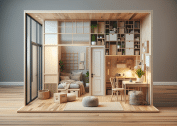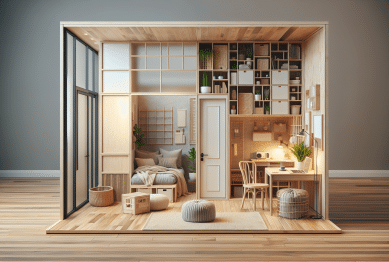Minimalist living captivates people who want a clutter-free home, more peace, and less stress. This guide explores why the idea keeps gaining popularity, how to start, and what real benefits it brings to daily life.
Understanding the Appeal of Minimalist Living
Minimalist living has moved from a niche lifestyle to a mainstream movement, especially among those craving simplicity. The idea is to clear out unnecessary items and focus on what is truly valuable to your happiness. People are drawn to minimalism as modern life tends to fill homes and schedules with things and activities that create stress instead of joy. When the space around you feels open and intentional, it can motivate a positive shift in how you use your time, money, and energy.
There is a widespread belief that owning more brings more happiness, but the principles of minimalist living flip that view entirely. Many who embrace minimalism report feeling less overwhelmed and more empowered. Instead of searching for ways to store extra items or keep up with trends, they find meaning in simplicity, functionality, and purpose. This trend can be seen in popular TV shows about decluttering and in a wave of books and podcasts that promote minimalism’s mental and emotional benefits.
Minimalist spaces emphasize quality over quantity. Clean lines, open areas, and simple décor dominate the aesthetic. But the core of minimalism is not the look—it’s the impact on your well-being. A minimalist mindset naturally frees up time for passions and relationships, while also reducing decision fatigue and pressure. No wonder this lifestyle is catching the attention of people eager for peace in a busy world.
Decluttering for Beginners: Small Changes, Big Impact
Anyone interested in minimalist living often starts with decluttering. Many experts recommend tackling one space at a time. Start with a single drawer or shelf so it doesn’t feel overwhelming. Assess what you truly use and enjoy. Often, items linger out of habit rather than need. By letting go of things that no longer serve a purpose, you open your environment to possibility and calm. Decluttering isn’t an event; it’s an ongoing process that becomes easier with practice.
Minimalist living isn’t about getting rid of everything. It’s about intentionality and being thoughtful about each possession. Ask: Does this item add value to my life? Many find donating, recycling, or selling items not only clears space but brings satisfaction. That process can reveal emotional attachments tied to belongings. When you work through those connections, you start focusing on experiences and relationships rather than just objects.
There are practical side benefits, too. A decluttered home is often easier to clean and maintain. It can also help save money, as people become more aware of what truly matters and avoid impulsive purchases. Over time, minimalist living fosters an environment that feels lighter, both physically and emotionally. Every small change can create a sense of relief, showing why so many people are ready to explore a simpler path.
The Psychology Behind Wanting Less
Why do people find minimalist living so satisfying? The answer often lies in the mental clarity it brings. Researchers point out that clutter bombards the mind with excess stimuli, making it harder to focus and process information (Source: https://www.apa.org/news/press/releases/2016/03/declutter-your-home). Minimizing distractions can reduce anxiety and elevate mood. Many studies connect less clutter and fewer possessions to lower stress levels and better overall well-being.
Psychologists also note that our attachment to things can lead to stress when space becomes overcrowded. Choosing quality items over quantity and surrounding oneself only with essentials fosters a sense of accomplishment and control. This self-discipline spills into other areas of life, including relationships, career goals, and personal routines — all of which benefit from a more mindful approach.
Minimalist living also opens doors to increased creativity and personal growth. Without constant distractions, the mind is free to imagine, solve problems, or simply relax. Many who have transitioned to minimalism report having more energy and time to enjoy their favorite activities. The overall effect on well-being often motivates people to continue the journey, making minimalism more of a lifestyle shift than a temporary trend.
Designing a Minimalist Space That Works for You
Interior design plays a crucial role in minimalist living, but that doesn’t mean every home needs to look the same. The key is creating spaces that feel restful. Simple, neutral palettes often dominate minimalist décor, with subtle pops of color adding warmth. Comfortable furniture—pieces chosen for their function and form—can help an open, uncluttered room feel inviting. The absence of excess lets you showcase what matters, whether that’s a well-loved sofa or a painting that brings joy.
Minimalist living can adapt to any home size. Small apartments become more functional with multi-use furniture and storage solutions that tuck away clutter. Even in larger homes, minimalist principles prevent the accumulation of unnecessary items over time. Many find joy in combining thoughtful layouts with a few cherished elements—plants, textiles, or books—that make the environment both personal and practical. There’s creative freedom in choosing which elements reflect minimalist values but still tell your story.
Some popular tips include keeping only items with a clear function or emotional resonance, eliminating unused décor, and organizing belongings so that everything has a designated place. Strategic lighting and mirrors can also create a sense of openness. Designing with intention, rather than trend-chasing, supports sustainable minimalist living. The result? A space that encourages relaxation and mindfulness every day you step in.
Minimalist Living and Sustainable Choices
Minimalist living naturally supports environmental sustainability. When people choose to buy less and invest in higher-quality, longer-lasting items, the demand for disposable products drops. Less waste heads to landfills, and fewer resources are needed for replacement goods (Source: https://www.epa.gov/recycle/reducing-waste-what-you-can-do). Minimalist living can mean embracing reusable materials, buying secondhand, or upcycling furniture rather than discarding it.
This way of living can inspire thoughtful consumption. Many minimalists research brands before making a purchase, looking for sustainability certifications or ethical production standards. They examine supply chains and manufacturing processes, seeking ways to reduce their ecological footprint. Even the act of decluttering aligns with eco-friendly habits—many prefer to recycle or donate rather than simply throw away. Each small decision can ripple out to broader environmental benefits.
Minimalist living and sustainability together foster a feeling of responsibility to the world beyond your own home. Cutting back on waste not only conserves resources but also influences others to consider their impact. Communities built around minimalist values often share tips about local recycling centers or clothing swaps. When lifestyle changes create both personal wellness and positive environmental impact, it’s easy to see why more people are inspired by this movement.
Cultivating Mindful Habits Every Day
Minimalist living doesn’t stop with the physical environment—it extends to everyday habits. Scheduling downtime without screens, practicing gratitude, and prioritizing intentional purchases are all part of a minimalist mindset. Some people start by setting daily routines that reduce stress, such as morning reflection or evening walks. These habits are simple but powerful for keeping life uncluttered and meaningful.
Mindfulness and minimalism often go hand in hand. Regularly reviewing what you own and do helps keep clutter at bay and goals in focus. Some people use journals or digital tools to track habits and reflect on personal growth. The process is ongoing and personalized. Minimalist living isn’t about achieving a perfect space or routine; it’s about creating room for more of what matters, whether that’s hobbies, rest, or time with loved ones.
As people continue to seek meaning and wellness in fast-paced, digital-driven cultures, minimalist living stands out as a lifestyle aligned with those goals. A focus on mindful decision-making infuses every part of daily life, fostering greater satisfaction and energy. Anyone can benefit from simple steps that lead to a more intentional, joyful experience—one uncluttered day at a time.
References
1. American Psychological Association. (2016). Declutter your home, declutter your mind. Retrieved from https://www.apa.org/news/press/releases/2016/03/declutter-your-home
2. United States Environmental Protection Agency. (n.d.). Reducing Waste: What You Can Do. Retrieved from https://www.epa.gov/recycle/reducing-waste-what-you-can-do
3. The Minimalists. (n.d.). Minimalism: A Documentary About the Important Things. Retrieved from https://www.theminimalists.com/documentary/
4. Mayo Clinic. (n.d.). Stress Management: Doing Mindful Meditation. Retrieved from https://www.mayoclinic.org/tests-procedures/meditation/in-depth/meditation/art-20045858
5. Harvard Health Publishing. (n.d.). Declutter your way to less stress. Retrieved from https://www.health.harvard.edu/mind-and-mood/declutter-your-way-to-less-stress
6. National Institute of Mental Health. (n.d.). Managing Stress. Retrieved from https://www.nimh.nih.gov/health/topics/caring-for-your-mental-health









